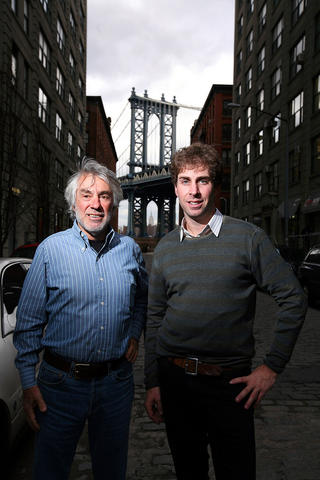George Dombek pays rent on his 130m2 light-filled studio at 20 Jay St with his paintings, which lately focus on water towers and upside-down tin pails on posts.
The Galapagos Art Space will pay around US$20 per square meter a year when it moves into a 102-year-old, 929m2 former stable at 16 Main St this spring.
St Ann's Warehouse, a performance space in an old spice-milling factory at 38 Water St, pays no rent at all.

PHOTO: THE NEW YORK TIMES
Some 1,000 artists and arts organizations are now working in the Dumbo section of Brooklyn, courtesy of the developers David Walentas and his son, Jed, partners in Two Trees Management. Operating on the principle that cultural ferment makes a neighborhood hot, Two Trees has offered creative people rents that they cannot refuse.
"It adds value to any neighborhood," David Walentas said in an interview at a conference table in his unflashy Dumbo office. "It's like good architecture. Good architecture is cheap and adds value. People will pay a premium for it."
Yet given the pace of gentrification, the future of the neighborhood's artists - and of Dumbo's artistic character - remains uncertain. Two months after Dumbo, named for its area Down Under the Manhattan Bridge Overpass, was designated a landmark in December, the City Planning Department proposed last week that the neighborhood be rezoned to allow taller buildings in high-density areas. Dumbo is historically considered to be the area between the Brooklyn and Manhattan Bridges and between the East River and Brooklyn-Queens Expressway, but blocks on the other side of the Manhattan Bridge are now often considered part of the area.
Mitchell Moss, a professor of urban policy and planning at New York University, gives David Walentas points for figuring out how to make a neighborhood vital. "He understands that you have to have creative energy," Moss said. "This is an intelligent and strategic move."
But some artists are troubled by the notion of developers using artists to help invigorate or market a neighborhood even as artists are priced out of more established areas.
"This really represents the broader picture, where cities are becoming impossible places for creative producers to live and work, where the notions of loft living and 'bohemian' become selling points in the development of real estate," the artist Barbara Kruger said. "Artists have nowhere else to turn so they take those work spaces. It's their work to make the neighborhood cool; then they can be moved out."
Other artists say David Walentas has a long-term commitment to culture in Dumbo and is simply speeding along a process that can't easily happen on its own because of rising commercial real-estate prices. "He's doing artificially what used to happen naturally over a longer period of time, like forcing a tulip bulb," said the artist Chuck Close, who serves on the board of the Marie Walsh Sharpe Art Foundation, which is based in Dumbo. "It doesn't happen organically the way it used to. Now you need a break."
"Clearly, he wants to make a buck," he added. "But it's community building."
The Two Trees developers, who own about 280,000m2 of property in Dumbo, tell their tenants that they will try to find other places for them in the area if their spaces are sold or developed. But they make no guarantees.
"Things change," David Walentas said. "Some will stay, some will die, some will move, some will go out of business. We can't solve all their problems.
The developers are up front with the tenants about the short-term nature of their leases.
"It was always straightforward," said Kathleen Gilrain, the executive director of Smack Mellon. "He doesn't spring stuff on us. Buildings are developed all over New York City, and those landlords don't give any space away."
When Two Trees converted 70 Washington St into condos, it offered almost every artist in the building below-market rates at one of its other buildings, 20 Jay St or 55 Washington St, and 80 percent accepted. "We're in a unique position to do these things because we own the whole neighborhood," Jed Walentas said.
They don't own all of it. While the Walentases say they would eventually like to move the St Ann's Warehouse organization to the brick ruins of the 19th-century Tobacco Warehouse in Empire-Fulton Ferry State Park, that property belongs to the state. They also want to convert the Empire Stores Warehouse, on Water Street between Dock and Main Streets, into studio and gallery space, but the state owns that too.
Affordable studios, galleries and stages are hard to come by in New York City. The Galapagos Art Space was on the verge of leaving Williamsburg, Brooklyn, for Berlin because its monthly rent had risen by US$10,000. David Walentas offered the company below-market space. "He's doing what the city should be doing," said Robert Elmes, director of Galapagos. "He's proving that it works."
The city, for its part, appreciates what Two Trees is doing.
"In an ideal world everyone would have space to work in perpetuity," said Kate Levin, the cultural affairs commissioner. "That's not the reality of New York real estate."
"He doesn't sweep in in the middle of the night and evict people," she added. "Providing space for people to make work and for people to come see it is a huge commitment."
David Walentas clearly enjoys coming to the rescue. "We've been very, very generous because I like it," he said. "I don't need the money. It's a way of putting people in my buildings."
On a recent tour of Dumbo he walked through some of these buildings, like the paint-splattered studios of the Triangle Arts Association at 20 Jay St (rent: free), where a visiting French artist, Gregory Forstner, was working on canvases of dogs in combat helmets. Walentas also showed off Smack Mellon's soaring new two-level gallery space on Plymouth Street, where huge pieces of sculpture were installed, and other tenants like the Brooklyn Arts Council, the Brooklyn Stained Glass Conservation Center and Dancing Diablo, an animation company (as well as the chocolate shop Jacques Torres and the bakery Almondine on Water Street).
"I'm very proud," Walentas said. "I tell people I've done a lot of things. They matter; they don't matter. In 100 years Dumbo will matter."

In the next few months tough decisions will need to be made by the Taiwan People’s Party (TPP) and their pan-blue allies in the Chinese Nationalist Party (KMT). It will reveal just how real their alliance is with actual power at stake. Party founder Ko Wen-je (柯文哲) faced these tough questions, which we explored in part one of this series, “Ko Wen-je, the KMT’s prickly ally,” (Aug. 16, page 12). Ko was open to cooperation, but on his terms. He openly fretted about being “swallowed up” by the KMT, and was keenly aware of the experience of the People’s First Party

Aug. 25 to Aug. 31 Although Mr. Lin (林) had been married to his Japanese wife for a decade, their union was never legally recognized — and even their daughter was officially deemed illegitimate. During the first half of Japanese rule in Taiwan, only marriages between Japanese men and Taiwanese women were valid, unless the Taiwanese husband formally joined a Japanese household. In 1920, Lin took his frustrations directly to the Ministry of Home Affairs: “Since Japan took possession of Taiwan, we have obeyed the government’s directives and committed ourselves to breaking old Qing-era customs. Yet ... our marriages remain unrecognized,

Not long into Mistress Dispeller, a quietly jaw-dropping new documentary from director Elizabeth Lo, the film’s eponymous character lays out her thesis for ridding marriages of troublesome extra lovers. “When someone becomes a mistress,” she says, “it’s because they feel they don’t deserve complete love. She’s the one who needs our help the most.” Wang Zhenxi, a mistress dispeller based in north-central China’s Henan province, is one of a growing number of self-styled professionals who earn a living by intervening in people’s marriages — to “dispel” them of intruders. “I was looking for a love story set in China,” says Lo,

Standing on top of a small mountain, Kim Seung-ho gazes out over an expanse of paddy fields glowing in their autumn gold, the ripening grains swaying gently in the wind. In the distance, North Korea stretches beyond the horizon. “It’s so peaceful,” says the director of the DMZ Ecology Research Institute. “Over there, it used to be an artillery range, but since they stopped firing, the nature has become so beautiful.” The land before him is the demilitarized zone, or DMZ, a strip of land that runs across the Korean peninsula, dividing North and South Korea roughly along the 38th parallel north. This